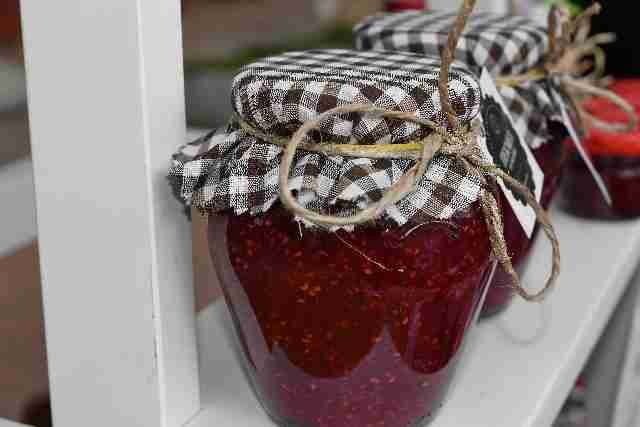Homemade Chia Jam
Do you have a hard time finding a jelly or jam that doesn’t have a ton of added sugar or high fructose corn syrup? Switching from sugar-filled jams found at the grocery store to homemade chia jam is a great way to improve your child’s diet and overall health. Traditional jams are often high in sugar and low in nutrients, which can contribute to weight gain and an increased risk of chronic diseases. By making your own chia jam, you can ensure that your child is getting a healthy and nutritious spread for their toast or sandwiches.
Chia jam is a healthier alternative that is packed with fiber, antioxidants, and omega-3 fatty acids, which are all essential for a growing child’s diet. Additionally, making your own chia jam allows you to control the amount of sugar you use, so you can ensure your child is not consuming too much sugar. By switching to chia jam, you can feel good about what your child is eating and be confident that you’re making a positive choice for their health.
Table of Contents

Chia jam is a delicious and healthier alternative to traditional jam. Made with just a few simple ingredients, chia jam is a great way to add a boost of nutrients to your breakfast or snacks. Chia seeds are high in fiber, antioxidants, and omega-3 fatty acids, making them a superfood that can help support overall health and wellness. In this blog post, we will explore the benefits of chia seeds, provide a recipe for making your own chia jam, and suggest some variations to customize the recipe to your taste. Whether you’re a fan of sweet, tangy, or spicy flavors, there’s a chia jam recipe out there for you!
Benefits of Using Chia Seeds in Homemade Chia Jam
Chia seeds are a nutrient-dense food that has been gaining popularity in recent years due to their numerous health benefits. These tiny seeds are packed with essential nutrients, including fiber, antioxidants, and omega-3 fatty acids. Here are some of the key benefits of chia seeds, as supported by scientific research:
- High in Fiber: Chia seeds are an excellent source of dietary fiber, with around 11 grams of fiber per ounce (28 grams). According to the Harvard School of Public Health, consuming a diet high in fiber can help lower cholesterol levels, regulate blood sugar, and promote regular bowel movements.
- Rich in Antioxidants: Chia seeds contain antioxidants, such as flavonoids, that can help protect the body against damage from free radicals. These antioxidants can also help reduce the risk of certain chronic diseases, such as cancer and heart disease.
- Good Source of Omega-3 Fatty Acids: Chia seeds are one of the best plant-based sources of omega-3 fatty acids, which are essential for maintaining heart health. According to a study published in the Journal of the Food Science and Nutrition, consuming chia seeds can help improve blood lipid levels, reduce inflammation, and lower the risk of heart disease.
- May Help with Weight Management: Chia seeds are high in fiber and protein, which can help you feel full for longer. A study published in the Journal of the American College of Nutrition found that consuming chia seeds can help reduce appetite and promote weight loss.
It’s important to note that more research is needed to fully understand the potential health benefits of chia seeds, but these studies suggest that adding chia seeds to your diet may be beneficial for overall health.
Variations to Homemade Chia Jam
The great thing about chia jam is that it’s a versatile recipe that can be customized to suit your taste. Here are a few variations to try:
- Different types of fruit: The recipe calls for berries, peaches, plums, etc. but you can experiment with different types of fruits such as: strawberries, blueberries, raspberries, blackberries, apricots, papaya, kiwi, etc.
- Sweetener options: The recipe calls for honey or maple syrup, but you can use other sweeteners such as agave nectar, stevia, or monk fruit sweetener. You can also adjust the amount of sweetener depending on how sweet you like your jam.
- Spices and extracts: Adding spices and extracts can give your chia jam a unique flavor. Try adding a pinch of cinnamon, nutmeg, or ginger for a warm and spicy flavor. Or, add a teaspoon of vanilla extract or almond extract for a subtle sweetness.
- Add nuts: Adding nuts like almonds, cashews, or walnuts can add a nice crunch to your chia jam.
- Mix it up: You can mix different fruits to make a mixed berry chia jam or a tropical chia jam. Be creative and have fun with it!
- Make it savory: Chia jam doesn’t have to be sweet. You can also make savory chia jam using vegetables like tomatoes, bell peppers, or eggplants.
By experimenting with different variations, you can create a chia jam that’s tailored to your taste preferences. Just remember to adjust the sweetener and spices accordingly.
Check out these tips to encourage kids to drink more water!
[penci_recipe]
Quick FAQs
Why is Chia Jam Healthy?
Chia jam is considered healthy because it is made with chia seeds, which are a nutrient-dense food that are packed with essential nutrients such as fiber, antioxidants, and omega-3 fatty acids.
Fiber is important for maintaining a healthy digestive system and can help lower cholesterol levels, regulate blood sugar levels and promote regular bowel movements. Antioxidants, such as flavonoids, can help protect the body against damage from free radicals and reduce the risk of certain chronic diseases such as cancer and heart disease. Omega-3 fatty acids are essential for maintaining heart health and can help improve blood lipid levels, reduce inflammation, and lower the risk of heart disease.
Can Chia seeds be used instead of pectin?
Yes, chia seeds can be used as a natural thickener instead of pectin in jam making. Chia seeds contain high amounts of soluble fiber, which when combined with liquid, forms a gel-like substance that can be used as a thickener. This gel-like substance can help to bind the fruits together, giving the jam its thick consistency.
When making chia jam, the chia seeds are typically added to the cooked fruit mixture and left to sit for a few minutes to thicken. The longer the mixture sits, the thicker the jam will become. This process is known as hydration, the chia seeds absorb the liquid, and their fibers form a gel.
When using chia seeds as a thickener, it’s important to keep in mind that they will thicken more once they are chilled, so it’s best to let the jam cool down in the refrigerator before consuming it.
Overall, chia seeds are a great natural alternative to pectin, but it’s important to experiment with the recipe and adjust the amount of chia seeds accordingly.
What nutrients are in chia seeds
Chia seeds are a nutrient-dense food that contains a variety of essential nutrients. Some of the key nutrients found in chia seeds include:
Fiber: Chia seeds are an excellent source of dietary fiber, with around 11 grams of fiber per ounce.
Protein: Chia seeds are also a good source of protein, with around 4 grams per ounce.
Omega-3 fatty acids: Chia seeds are one of the best plant-based sources of omega-3 fatty acids, which are essential for maintaining heart health.
Antioxidants: Chia seeds contain antioxidants, such as flavonoids, that can help protect the body against damage from free radicals.
Minerals: Chia seeds are also a good source of minerals like calcium, phosphorus, magnesium, and manganese.
Vitamins: Chia seeds also contain small amounts of vitamins, like Vitamin A and Vitamin K.
Do chia seeds contain phytic acid?
According to a study by Da Silva et al. (2017), the amounts of phytic acid in chia seeds range between 0.96 and 1.16 g/100 g. EFSA (2018) noted the phytic acid content of white and whole wheat flour (about 0.4 g/100 g and 2.2 g/100 g, respectively), and of rye, rice, barley and oat flours (range: 0.45–0.75 g/ 100 g) as reported by Garcia-Estepa et al. (1999). These authors also indicated that the phytic acid content reported in other studies shows a wide variability depending on flour yield, and flour types (range 0.15–0.32 g/100 g in white flour and 0.96–1.75 g/100 g in whole wheat flour). The authors reported the phytic acid content of brans (wheat brans: 2.5–5.8 g/100 g; oat brans: 2.0 g/100 g; rice bran: 5.8 g/100 g). EFSA also notes the phytate content of wheat and whole wheat flour (0.28 and 0.84 g/100 g, respectively) as reported by OECD in the consensus document on the composition of Triticum aestivum (OECD, 2003). Thus, the Panel considers that the content of phytates in chia seeds is comparable to the contents in cereal grains and does not raise a safety concern. This information was pulled from this study.
Does soaking chia seeds reduce phytic acid content?
Biological processing techniques, such as soaking, germination, malting, cooking, hydrothermal processing and fermentation, result in the phytate dephosphorylation of the food. Phytate is water-soluble, so a considerable amount of phytate is removed to the water. Retrieved from this paper.


